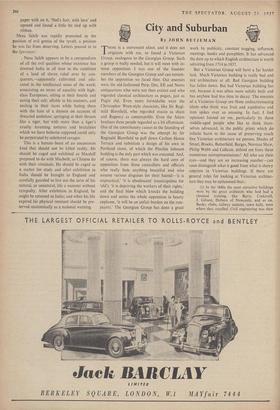City and Suburban
By JOHN BETJEMAN THERE is a movement afoot, and it does not originate with me, to found a Victorian Group, analogous to the Georgian Group. Such a group is badly needed, but it will meet with in- tense opposition. I was one of the founder members of the Georgian Group and can remem- ber the opposition we faced then. Our enemies were the old-fashioned Perp, Dec, EE and Norm antiquarians who were not then extinct and who regarded classical architecture as pagan, just as Pugin did. Even more formidable were the Christopher Wren-style classicists, like Sir Regi- nald Blomfield, who regarded stucco as sham and Regency as contemptible. Even the Adam brothers these people regarded as a bit effeminate. One of the contributory causes to the founding of the Georgian Group was the attempt by Sir Reginald Blomfield to pull down Carlton House Terrace and substitute a design of his own in Portland stone, of which the Pinchin Johnson building is the only part which was executed. And, of course, there was always the hard core of opposition from those councillors and officials who really hate anything beautiful and who assume various disguises for their hatred—'it is unpractical,' it is obsolescent' (municipalese for 'old'), 'it is depriving the workers of their rights,' and the final blow which knocks the building down and unites the whole opposition in hearty applause, 'it will be an unfair burden on the rate- payers.' The Georgian Group has done a great work by publicity, constant nagging, influence, meetings, books and pamphlets. It has advanced the date up to which English architecture is worth admiring from 1714 to 1837.
But a Victorian Group will have a far harder task. Much Victorian building is really bad and not architecture at all. Bad Georgian building has fallen down. But bad Victorian building has not, because it was often more solidly built and has anyhow had less time to decay. The enemies of a Victorian Group are those undiscriminating idiots who think wax fruit and aspidistras and iron spikes ever so amusing. In fact, I find opinions foisted on me, particularly by those middle-aged people who like to think them- selves advanced, in the public prints which do infinite harm to the cause of preserving much fine Victorian architecture we possess. Shades of Street, Brooks, Butterfield, Burges, Norman Shaw, Philip Webb and Collcutt, defend me from these monstrous misrepresentations! All who use their eyes—and they are an increasing number—can Soon distinguish what is good from what is showy copyism in Victorian buildings. If there are general rules for looking at Victorian architec- ture they may be epitomised thus : (1) In the 1840s the most attractive buildings were by the great architects who had had a classical training, like Barry, Cockerell,
J. Gibson, Dobson of Newcastle, and so on. Banks, clubs, railway stations, town halls, were where they excelled. Civil engineering was (hen (2) In the Fifties and Sixties the Gothic re- vival ceased to be mere oopying of mediwval, and the Church of England led the way with big-boned churches in brick and local stone which reflected the sturdy Tractarian individual- ism of their architects—men such as Butterfield and Street, Pearson and Brooks.
(3) In the Seventies and Eighties England made her greatest contribution to the architec- ture of the Western world since the emergence of the Perpendicular style—she invented the 'small house for artistic people of moderate in- come,' and with it went the arts and crafts movement with William Morris as chief decorator and Norman Shaw as chief architect, both pupils of the ebullient Mr. Street. Bedford Park (1878), its children Port Sunlight, Bourne- ville, Welwyn, Letchworth, Hampstead Garden Suburb, are all Victorian in inspiration.
The enemies of the Victorian Group are not only those who think Victorian architecture merely 'funny' and 'sweet' and a matter of drink- ing fountains and iron spikes and coloured tiles. They are also a kind of sentimentalist who re- gards preservations as something immoral and stopping brilliant young architects from having a chance. These sentimentalists, who are usually sightless beauty-haters, when questioned do not quite know what they mean by the modern style. They talk vaguely about 'clean lines' and 'the future'—their future being some sort of Orwell, classless, hygienic world of indeterminate structure. There is today in America much fine architecture in the modern style. Frank Lloyd Wright is really an extension of the William Morris arts and crafts movement and influenced by Japanese paper houses. But he and his fol- lowers build for the rich, and fine, light, original houses are the result. The few very rich People in England buy old houses and repair them. America has not enough to go round. In England the best young architects—firms like Powell and Moya—are geared not to the build- ing of individual houses for millionaires but to huge building estates for borough and county councils. Here some of the best, and some of the worst and most inhuman, contemporary architec- ture is to be found. This sort of architecture, where it is good, is not inconsistent with preser- vation, nor hostile to good Victorian.
The use of our eyes is going to be the only means with which we may found a Vic- torian Group as effective as its Georgian brother. The use of our eyes, too, can tell us the difference between good and indifferent in contemporary architecture. If you want to see it, look at the rather dull, safe and harmless 'contemporary' going up at South Kensington and contrast it with the robust flamboyance of the Imperial In- stitute. It seems to me to be the equivalent of Blomfield's smooth and lifeless Pinchin Johnson building set in the stucco swagger of Carlton House Terrace.































 Previous page
Previous page